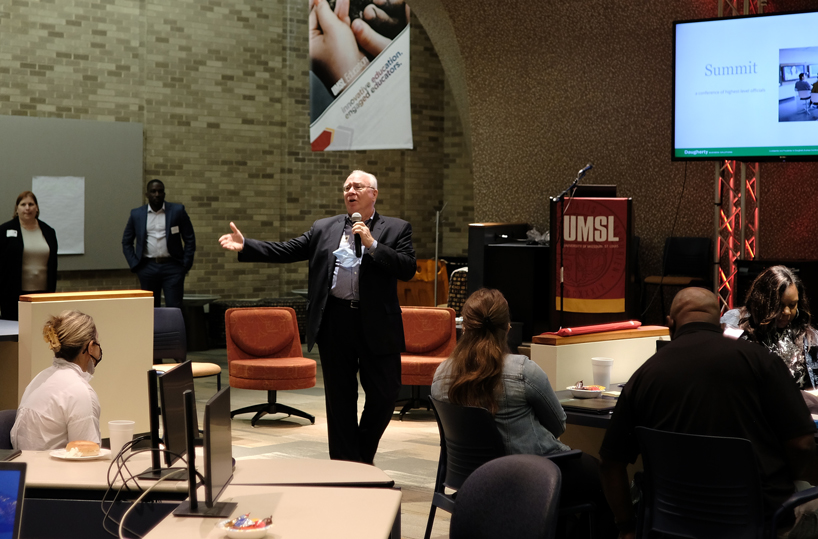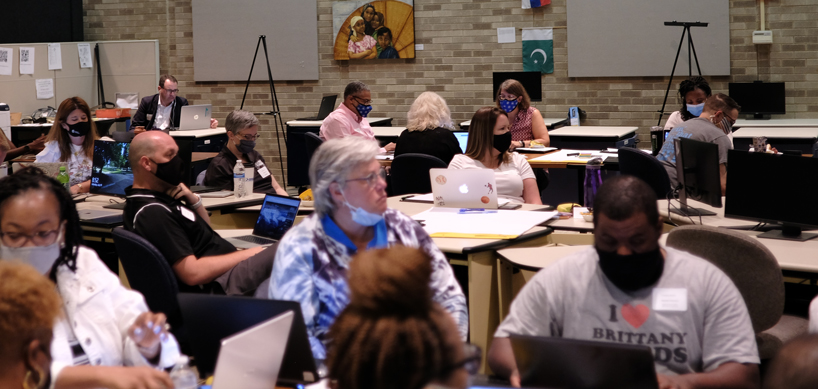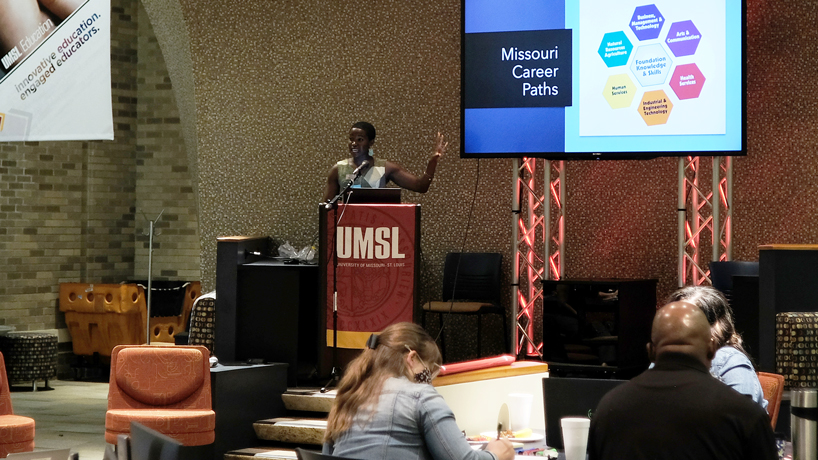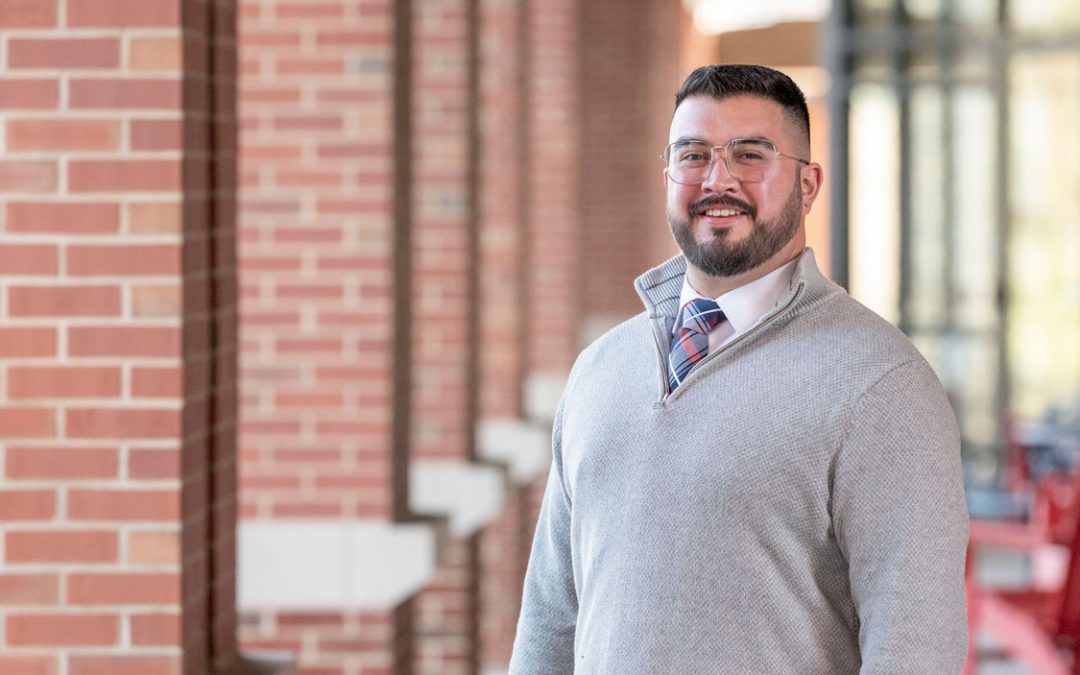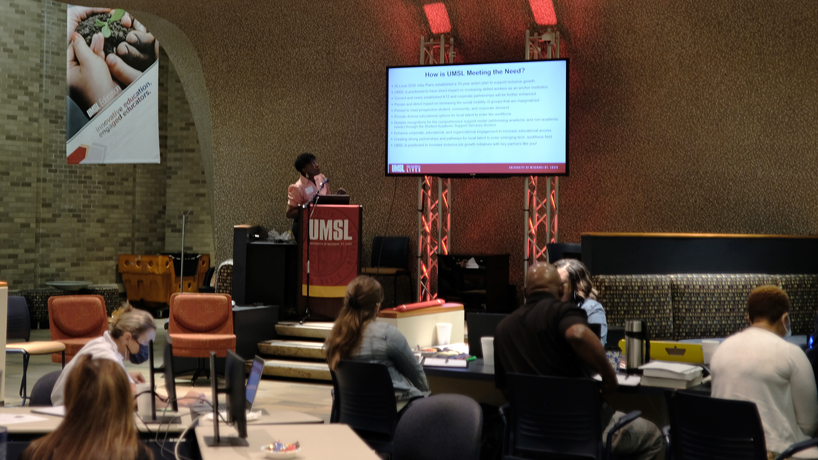
Natissia Small, UMSL’s vice provost for access, academic support and workforce integration, delivers the opening address at last week’s IT Career Summit, hosted in partnership with Daugherty Business Solutions and the School District of University City, in the College of Education’s Technology and Learning Center. (Photos by Steve Walentik)
Natissia Small had a call to action for the room full of K-12 teachers, counselors and administrators as she looked up from behind her lectern in the College of Education’s Technology and Learning Center last week at the University of Missouri–St. Louis.
They had come – more than 60 educators from 11 school districts spread throughout the St. Louis region – to take part in a three-day IT Career Summit hosted by UMSL in partnership with Daugherty Business Solutions and the School District of University City.
Small, UMSL’s vice provost for access, academic support and workforce integration, delivered the opening address last Monday morning.
“It could not be more important than it is right now,” she said. “We must begin to work even more collaboratively, like we have never before. We’ve got to do more when it comes to career development. We need to increase the local talent pool in this region, increase educational access to resources, networking opportunities. There’s so much that we have to do in order to increase those areas – to meet the employment and training needs for businesses, as well as job seekers. Create assessable opportunities for apprenticeships, certifications, stackable credentials and then make sure that we’re removing all of those barriers that can come into play when folks are simply trying to get to another level in their educational career path.”
Daugherty Business Solutions Vice President Lee Metcalf helps welcome teachers to last week’s IT Career Summit.
Small’s message is relevant to a number of fields across the state of Missouri, including agribusiness, biosciences, education, energy, financial and professional services, health care, hospitality and food service, but last week’s summit focused specifically on information technology, where the there is a shortage of quality IT professionals.
The St. Louis region could have 3,000 to 4,000 new technology jobs that need to be filled over the next four years, Small said, and the summit was a chance to highlight the importance of local school districts to help fill that need.
“I’m a really strong supporter of Launch Code and Power,” said Lee Metcalf, vice president at Daugherty Business Solutions. “All of them that are out there – they’re doing the Lord’s work trying to connect the dots for folks who are looking for good jobs and moving over into IT. However, a boot camp is not enough. The reality is it starts, well, all the way to K, but because these jobs are opening in the next three years, we’re focused on your high school talent pool right now – your freshmen, sophomores, juniors, your rising seniors. How can we align them even better with what the skills are that are being looked at? And how to get them into the classes that you have in each of your institutions?”
Teachers, school counselors and administrators from 11 school districts across the St. Louis region attended last week’s IT Career Summit.
The educators – from St. Louis Public Schools, Clayton, Ferguson-Florissant, Hazelwood, Jennings, Ladue, Maplewood Richmond Heights, Normandy, Parkway, Pattonville and University City – heard from industry leaders at organizations such as Evernorth, Clayco, Mastercard and Daugherty Business Solutions to hear about the needs of the business community.
They also had discussions about how they might increase the rigor of their IT curriculum as they look to both inspire more students to consider IT careers and prepare them to take advantage of opportunities. They shared curriculum development strategies, ideas for student and workforce engagement and ways to achieve diversity across background, skill and thought.
The summit also helped them think through how to effectively connect high school students to the workforce.
Mary Edwin, an assistant professor in the College of Education’s Department of Education Sciences and Professional Programs, talked about the importance of building pathways that lead students toward career opportunities.
Mary Edwin, an assistant professor in the Department of Education Sciences and Professional Programs, advocates building career pathways to benefit students.
“What we’re seeing is that one in three high school graduates are leaving high school and not going to college, which means they’re not getting a degree that we know nationally tends to be needed for success,” Edwin said. “But they’re also not going straight into work. They’re not finding meaningful work that will allow them to achieve the kind of economic success that they’re looking for.”
Edwin also cited data showing that only about 60% of first-time undergraduates finish a four-year degree within six years. That extra time in school they spend decided on a major or figuring out how their intended major will lead them to a career, means they’re racking up debt.
That debt doesn’t go away if they don’t finish the degree, but it does become more difficult to pay off.
Edwin advocated a different approach.
“Career Pathways offer routes to skilled professions and coordination with employers with guidance that helps us support students in their career development,” she said. “Each step in a pathway allows the student to gain a marketable skill set and credential that prepares them for the next job on the career path. So, career path education really just involves educating students and other stakeholders about available career pathways, and the necessary steps and routes that students can take to obtain the needed skills and credentials for success in their chosen pathway.”
High school students following a pathway toward a career of their choosing don’t have to forgo higher education as they advance. Earning a college degree can enhance their credentials as they move forward.

